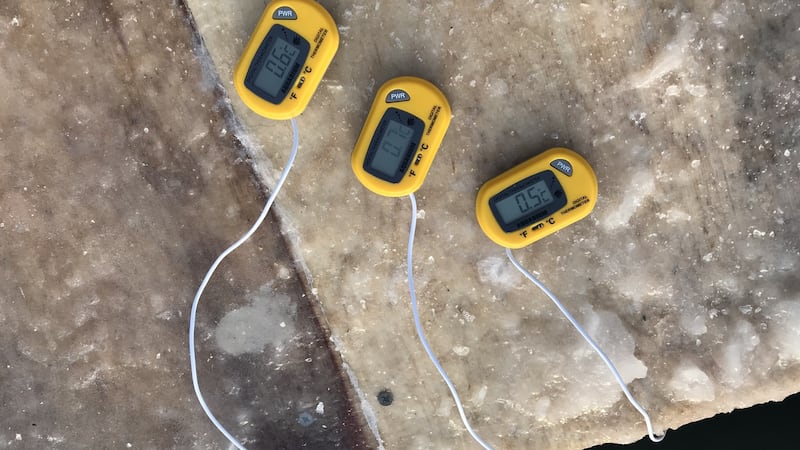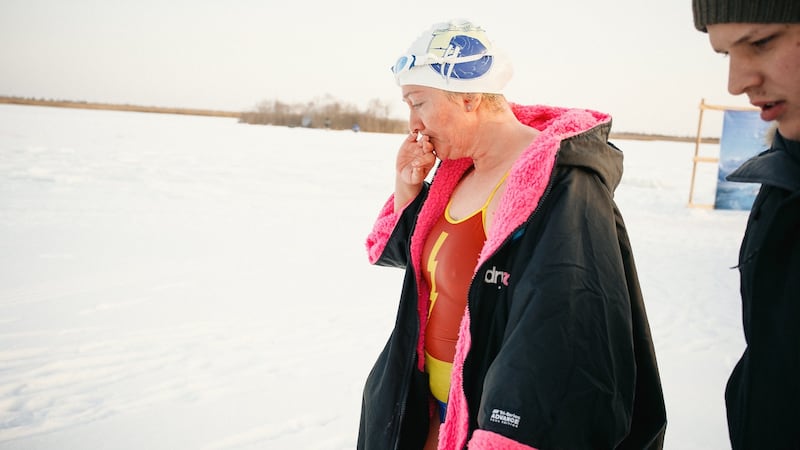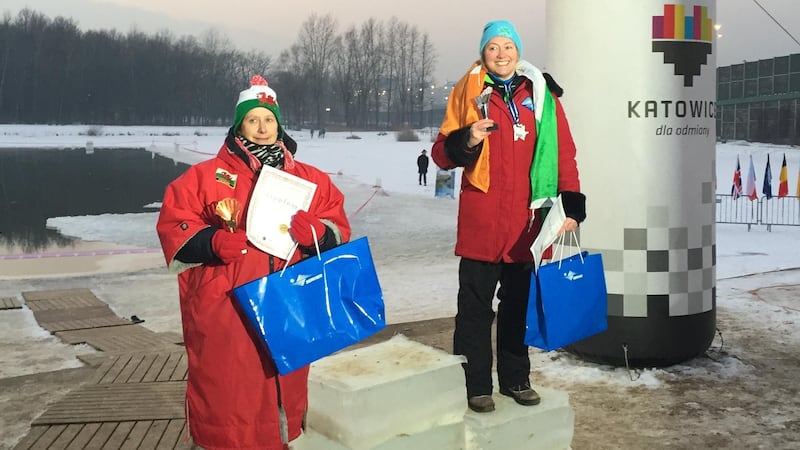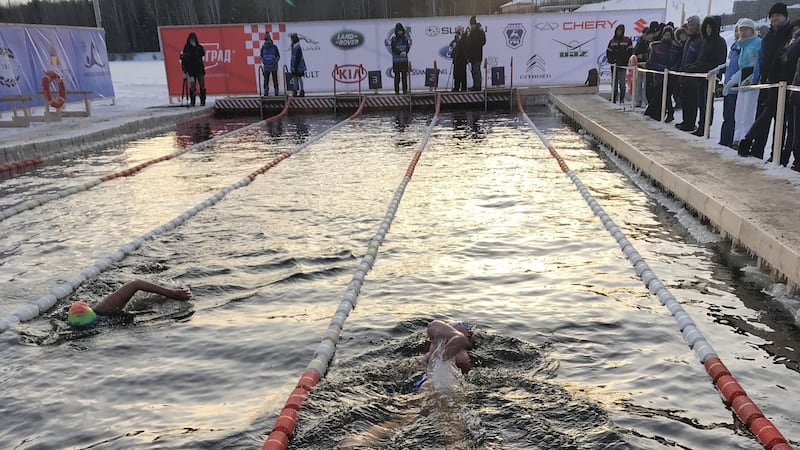Swimming in ice requires a certain determination, but also chain-saws to cut the ice and form racing lanes. A sauna is also needed and apparently hot chocolate helps a lot.
Tiffiny Quinn is one of 12 hardy Irish swimmers travelling to the Artic Circle for a St Patrick's Day dip at the ice swimming world championships.

The rules say the water temperature must be less than five degrees for racing. But Quinn says at Russian events it can dip as low as zero. Pumps keep the water moving so it doesn’t re-freeze mid-race. Staff use hammers to knock icicles off the starting area.
Despite competing around Europe and training in cold Irish waters, she admits the first time she swam in Siberia was daunting. That’s a 450-metre race through Siberian ice in an ordinary swimsuit.
“It was probably the scariest thing I’ve ever done. When you come out of the swim, your whole body is red and if you’ve been in too long, there’s patches of black where the blood is starting to pool. You’re not at the frostbite stage. They take you to a tent and wrap you in warm towels. Your hands and feet get put into cold water which is absolute torture.
“The important thing is to heat your core. The towels are cold in seconds and replaced with gradually hotter towels. It’s very comforting.”
Trained recovery staff
Trained recovery staff do this, knowing to avoid rubbing the skin for example as it’s too sensitive to touch. Some swimmers enter a daze after leaving the water as with their bodies concentrating on warming there is no energy for speaking. Quinn says this can last 10 minutes, saying family are advised to avoid the recovery area as it can appear more serious than it is.
“It is a very dangerous sport but handled well it’s fine. When they say I’m cold, that’s good, and when they start shivering, that’s great,” she says.
Swimmers then go to a sauna, heated only to about 40 degrees, so not as hot as in the typical gym or hotel sauna. A hot tub or hot air is the final stage.

International Ice Swimming Association rules provide for a "second" who watches each swimmer from start to finish for safety reasons. The rules also warn: "IISA will not and cannot take any responsibility for any death, injuries or losses suffered as a consequence. All swimmers must participate at their own risk."
That’s clear then.
And all quite normal for Quinn. “I love the cold, I genuinely like the cold. People think about different things when they’re racing, you have to keep your thoughts away from the cold. I usually think about the strokes and rotation, the kicking of my legs.”
Ireland’s coldest waters
In Ireland swimmers rarely actually push through ice but they seek out the coldest waters here. Quinn trains with the Forty Foot Walrus Winter Swimmers in Dublin and they also spend a lot of time in the recently reopened Clontarf Baths. The manager phones Quinn when the water temperature drops below five degrees.
Lough Dan in Wicklow or the neighbouring Glendalough lakes are also good preparation for the Arctic Circle apparently. Irish championships take place annually at Wild Water Armagh, just outside the Armagh town.
Quinn says the secret weapon in this extreme sport is cake, and lots of it. Body fat can help with warmth, although she points out that training and acclimatising are crucial before trying out really icy waters.
“Cake is important,” says Quinn, “it’s part of our training regime. You need to have body fat to keep warm in there; the sport attracts rounder people, and people tend to put on weight when they’re training. It’s one of the few sports where that happens – ice-swimming and sumo I suppose. It’s basic physics; you need fat to keep your organs warm.”

The current world record for the fastest 1km swim in ice was set at the World Cup in January, when Germany’s Alisa Fatum swam faster than both male and female competitors coming in at 12.48.70.
“The numbers for men and women competing are pretty close,” Quinn says. “I wouldn’t call it a male-dominated sport.”
Dender differences
But she says there are differences in how women and men handle the cold. When she competed in Siberia, she found other female swimmers helpful in spite of the language barrier. Chocolate was shared around the changing tent, and they all walked out to the water holding hands together.
In contrast, her male team-mates described macho posturing and bragging as everyone in their tent pretended the cold wasn’t even a consideration. Support for nerves was thin on the ground.
Twelve Irish swimmers, men and women, race at the World Championships; all self-funded. Quinn is chair of the Irish association and says sponsorship from BT Ireland and Red Bull covers the team gear.
Races take place in age categories as with Masters Swimming.
“I am not swimming the 1km this year,” says Quinn, “just decided for the 500m and 200m. I’m better at those distances. It’s in a lake. The water will be zero and minus 20 outside so it’s scary.”

A bit colder than the last Irish championships when the water was 4.9 degrees with seven degrees air temperature. A day Quinn describes as “irritatingly mild”.
So while other people pay for expensive cryotherapy to treat injuries, it comes free with racing in ice. “If you have any physical pains, the cold takes it away. I’ve had pains in my knees, in my shoulder, just from life, and on getting into the cold it goes away. We call it the Control-Alt-Delete; you get in and get re-set. It’s like the cold shuts everything down and reboots you.” she says.
The Irish team uses ice-baths to acclimatise their bodies for the lower water temperatures. Public sessions in ice-baths on Howth Pier are set for February 16th and March 2nd at 11am to fundraise for the RNLI and practise being cold.
Quinn says the effectiveness of this is debated in the racing community, but she feels if she can cope a long time in the bath without moving then swimming is more bearable.
Heightened experience
“Swimming in ice is like sea swimming, but the cold heightens the experiences. There is a ridiculous high. There is a biochemical reason; your body is thinking we are shutting down, it’s in survival mode. But then you come out and you warm up slowly. Endorphins get dumped through your system and you are high as a kite,” she says.
Quinn describes the swimmers after their Saturday morning dip in Clontarf as very quiet at first but as the hot chocolate takes effect, everyone becomes giddy. She adds: “And it doesn’t diminish, the next week will be the same. It makes you feel good.”
Next year Quinn and 19 Irish swimmers head to Antarctica for a swimming holiday. Naturally the boat spec includes a large sauna.
Swimmers find this outdoor training, far from the distractions of phones and screens, has mental health benefits too. Quinn talks about the so-called “blue effect” coming from being surrounded by open water.
“For me if I get into the sea and it’s cold, you almost feel insignificant in a positive way. It’s so vast, so whatever thing is ailing you it suddenly seems not as important when you are confronted with the vastness of the sea. Then you are being held and supported by the salt. You feel everything is going to be okay,” she says.
Contact the International Ice Swimming Association Ireland on Facebook for more information.





















